语言学期末复习资料
- 格式:doc
- 大小:60.50 KB
- 文档页数:13
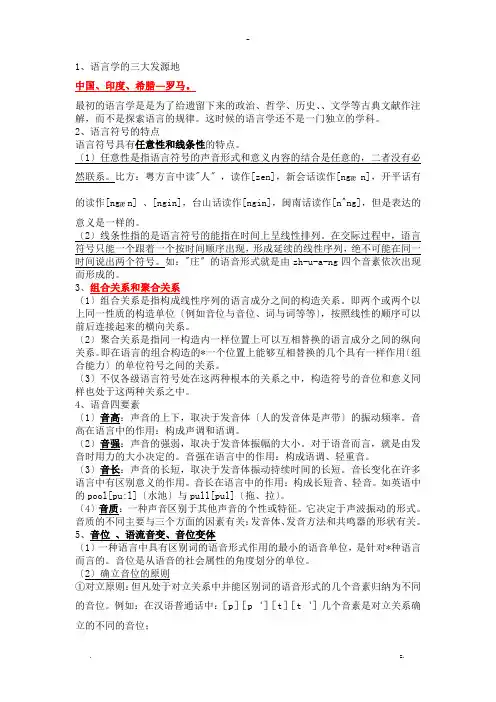
1、语言学的三大发源地中国、印度、希腊—罗马。
最初的语言学是是为了给遗留下来的政治、哲学、历史、、文学等古典文献作注解,而不是探索语言的规律。
这时候的语言学还不是一门独立的学科。
2、语言符号的特点语言符号具有任意性和线条性的特点。
〔1〕任意性是指语言符号的声音形式和意义内容的结合是任意的,二者没有必然联系。
比方:粤方言中读"人〞,读作[zen],新会话读作[ngæ n],开平话有的读作[ngæn] 、[ngin],台山话读作[ngin],闽南话读作[n^ng],但是表达的意义是一样的。
〔2〕线条性指的是语言符号的能指在时间上呈线性排列。
在交际过程中,语言符号只能一个跟着一个按时间顺序出现,形成延续的线性序列,绝不可能在同一时间说出两个符号。
如:"庄〞的语音形式就是由zh-u-a-ng四个音素依次出现而形成的。
3、组合关系和聚合关系〔1〕组合关系是指构成线性序列的语言成分之间的构造关系。
即两个或两个以上同一性质的构造单位〔例如音位与音位、词与词等等〕,按照线性的顺序可以前后连接起来的横向关系。
〔2〕聚合关系是指同一构造内一样位置上可以互相替换的语言成分之间的纵向关系。
即在语言的组合构造的*一个位置上能够互相替换的几个具有一样作用〔组合能力〕的单位符号之间的关系。
〔3〕不仅各级语言符号处在这两种根本的关系之中,构造符号的音位和意义同样也处于这两种关系之中。
4、语音四要素〔1〕音高:声音的上下,取决于发音体〔人的发音体是声带〕的振动频率。
音高在语言中的作用:构成声调和语调。
〔2〕音强:声音的强弱,取决于发音体振幅的大小。
对于语音而言,就是由发音时用力的大小决定的。
音强在语言中的作用:构成语调、轻重音。
〔3〕音长:声音的长短,取决于发音体振动持续时间的长短。
音长变化在许多语言中有区别意义的作用。
音长在语言中的作用:构成长短音、轻音。
如英语中的pool[pu:l]〔水池〕与pull[pul]〔拖、拉〕。
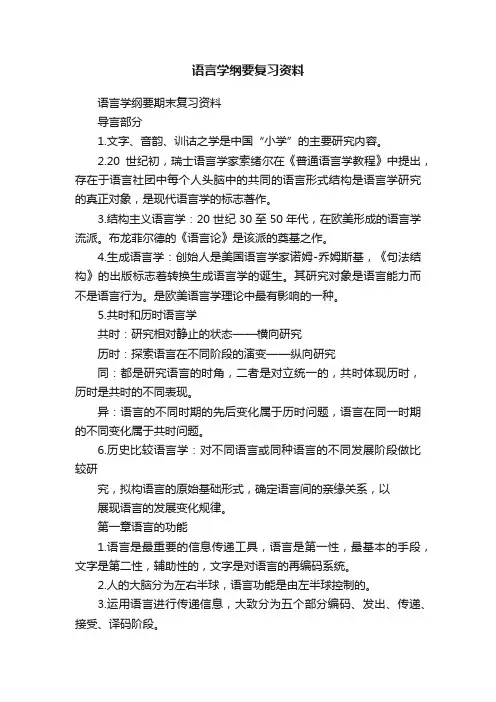
语言学纲要复习资料语言学纲要期末复习资料导言部分1.文字、音韵、训诂之学是中国“小学”的主要研究内容。
2.20世纪初,瑞士语言学家索绪尔在《普通语言学教程》中提出,存在于语言社团中每个人头脑中的共同的语言形式结构是语言学研究的真正对象,是现代语言学的标志著作。
3.结构主义语言学:20世纪30至50年代,在欧美形成的语言学流派。
布龙菲尔德的《语言论》是该派的奠基之作。
4.生成语言学:创始人是美国语言学家诺姆-乔姆斯基,《句法结构》的出版标志着转换生成语言学的诞生。
其研究对象是语言能力而不是语言行为。
是欧美语言学理论中最有影响的一种。
5.共时和历时语言学共时:研究相对静止的状态——横向研究历时:探索语言在不同阶段的演变——纵向研究同:都是研究语言的时角,二者是对立统一的,共时体现历时,历时是共时的不同表现。
异:语言的不同时期的先后变化属于历时问题,语言在同一时期的不同变化属于共时问题。
6.历史比较语言学:对不同语言或同种语言的不同发展阶段做比较研究,拟构语言的原始基础形式,确定语言间的亲缘关系,以展现语言的发展变化规律。
第一章语言的功能1.语言是最重要的信息传递工具,语言是第一性,最基本的手段,文字是第二性,辅助性的,文字是对语言的再编码系统。
2.人的大脑分为左右半球,语言功能是由左半球控制的。
3.运用语言进行传递信息,大致分为五个部分编码、发出、传递、接受、译码阶段。
4.思维方式的差异更多地体现在不同语言在表达思想时语法方面的特点。
5.思维能力的普遍性和思维方式的特殊性,与语言的性质是密切相关的。
6.语言和言语的区分是索绪尔提出的,言语不稳定,语言是稳定的。
7.语言是符号系统,是最重要最典型的符号,符号的形式和意义是约定,无必然联系。
征候是事物本身的特征,它传递的某种信息,可以通过它自身的物质属性来推断。
(远处的炊烟、病人的脉象、气色、舌苔、口气,罪犯的指纹,脚印)8.音————义————心理现实————客观现实语言符号指称反映客观现实:是四维时空中外在于人的所有存在,当下和历史上所有的人物、事物、现象以及他们的相互关系及其变化。
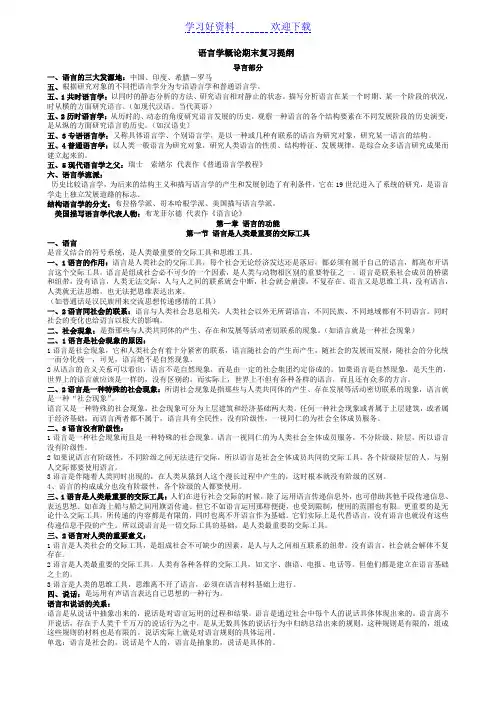
语言学概论期末复习提纲导言部分一、语言的三大发源地:中国、印度、希腊-罗马五、根据研究对象的不同把语言学分为专语语言学和普通语言学。
五、1共时语言学:以同时的静态分析的方法、研究语言相对静止的状态。
描写分析语言在某一个时期、某一个阶段的状况,时从横的方面研究语言。
(如现代汉语、当代英语)五、2历时语言学:从历时的、动态的角度研究语言发展的历史,观察一种语言的各个结构要素在不同发展阶段的历史演变,是从纵的方面研究语言的历史。
(如汉语史)五、3专语语言学:又称具体语言学、个别语言学,是以一种或几种有联系的语言为研究对象,研究某一语言的结构。
五、4普通语言学:以人类一般语言为研究对象,研究人类语言的性质、结构特征、发展规律,是综合众多语言研究成果而建立起来的。
五、5现代语言学之父:瑞士索绪尔代表作《普通语言学教程》六、语言学流派:历史比较语言学,为后来的结构主义和描写语言学的产生和发展创造了有利条件,它在19世纪进入了系统的研究,是语言学走上独立发展道路的标志。
结构语言学的分支:布拉格学派、哥本哈根学派、美国描写语言学派。
美国描写语言学代表人物:布龙菲尔德代表作《语言论》第一章语言的功能第一节语言是人类最重要的交际工具一、语言是音义结合的符号系统,是人类最重要的交际工具和思维工具。
一、1语言的作用:语言是人类社会的交际工具,每个社会无论经济发达还是落后,都必须有属于自己的语言,都离布开语言这个交际工具。
语言是组成社会必不可少的一个因素,是人类与动物相区别的重要特征之一。
语言是联系社会成员的桥梁和纽带,没有语言,人类无法交际,人与人之间的联系就会中断,社会就会崩溃,不复存在。
语言又是思维工具,没有语言,人类就无法思维,也无法把思维表达出来。
(如普通话是汉民族用来交流思想传递感情的工具)一、2语言同社会的联系:语言与人类社会息息相关,人类社会以外无所谓语言,不同民族、不同地域都有不同语言。
同时社会的变化也给语言以极大的影响。

语言学复习资料-精整版1、历史比较语言学:是运用历史和比较两种方法,发现几种语言在历史演变中的对应规律从而确定语言的亲属关系,构拟产生这些亲属语言的原始母语。
2、组合关系:语言符号与符号之间组成的言语链条关系叫组合关系。
组合关系是一种现实的、有顺序的、可数的横向关系。
3、聚合关系:在链条某一环节上能够互相替换的,具有相同作用的符号聚积成类的关系叫聚合关系。
聚合关系是一种联想的、无顺序、不易精确数出来的纵向关系。
4、语言的融合:一种语言战胜另一种语言或一种语言被另一种语言吞噬的现象,叫做语言的融合。
5、语言的层级性:语言系统是一套层级装置,底层是一套音位装置,上层分为语素、词、句子三层。
6、音素:音素是人类语言在一次发音中从音质角度切分出来的最小的语音单位。
7、音位:音位是具体语言在一类发音中从能否区别词或语素的角度划分或归并出来的最小的语音形式。
8、国际音标:国际音标是国际语音协会于1888年公布的一套记音符号。
大部分符号采用拉丁字母,少数用希腊字母,还有的采用大小写、正反写、合体写或添加符号与改变符号等方法。
国际音标可分为宽式音标和严式音标两种。
它的优点是形体简便,记音准确、灵活、完备。
9、音位变体:可归并为同一个音位的各个音素,我们称之为音位变体。
10、非音质音位:利用音高、音长、音强这些非音质要素形成的音位叫非音质音位。
11、语义:指语音形式表现出来的语言和言语的全部内容,它包括语言意义和言语意义两大类。
12、义素:义素是对某个义位的语义特征进行分析后得到的最小的语义单位。
13、语义场:语义场就是归属于一个总称之下的在意义上紧密联系的一组词的义位的聚合体。
14、语境:语言环境简称语境,指人们用语言进行交际时的具体环境。
15、词:词是语言中可以独立运用的最小音义结合单位。
16、语素:语素是语言中不能独立运用的最小的音义结合单位。
17、词缀:词缀指附着在词根之上的语素,它对词义的构成起附加作用。
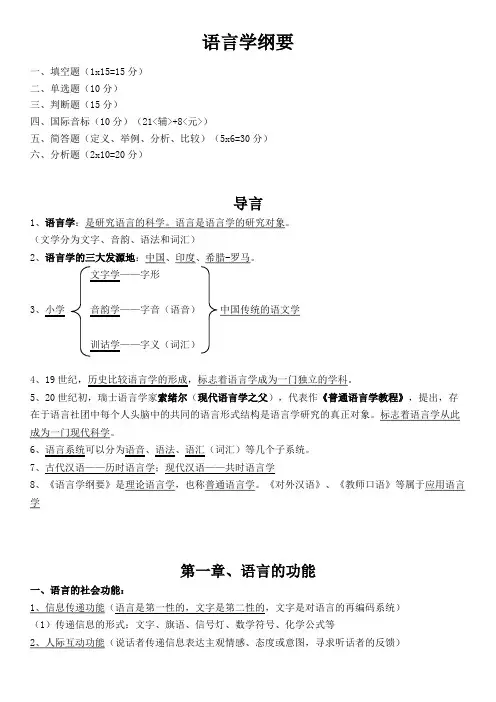
语言学纲要一、填空题(1x15=15分)二、单选题(10分)三、判断题(15分)四、国际音标(10分)(21<辅>+8<元>)五、简答题(定义、举例、分析、比较)(5x6=30分)六、分析题(2x10=20分)导言1、语言学:是研究语言的科学。
语言是语言学的研究对象。
(文学分为文字、音韵、语法和词汇)2、语言学的三大发源地:中国、印度、希腊-罗马。
3、小学中国传统的语文学4、19世纪,历史比较语言学的形成,标志着语言学成为一门独立的学科。
5、20世纪初,瑞士语言学家索绪尔(现代语言学之父),代表作《普通语言学教程》,提出,存在于语言社团中每个人头脑中的共同的语言形式结构是语言学研究的真正对象。
标志着语言学从此成为一门现代科学。
6、语言系统可以分为语音、语法、语汇(词汇)等几个子系统。
7、古代汉语——历时语言学;现代汉语——共时语言学8、《语言学纲要》是理论语言学,也称普通语言学。
《对外汉语》、《教师口语》等属于应用语言学第一章、语言的功能一、语言的社会功能:1、信息传递功能(语言是第一性的,文字是第二性的,文字是对语言的再编码系统)(1)传递信息的形式:文字、旗语、信号灯、数学符号、化学公式等2、人际互动功能(说话者传递信息表达主观情感、态度或意图,寻求听话者的反馈)二、语言的思维功能:(了解)1、大脑左半球(左脑)控制语言功能以及相关的计数、分类、推理等功能,掌管抽象的、概括的思维2、大脑右半球(右脑)在音乐等艺术感知,人的面貌识别、立体图形的识别、整体把握能力、内在想象力等方面起主要作用,掌管不需要语言的感性直观思维。
3、聋哑人是有思维的。
第二章、语言是符号系统1、符号:(1)概念:指一个社会全体成员共同约定的用来表示某种意义的记号或标记Eg:烽火戏诸侯、电梯的着火铃(2)包括:形式与意义两个方面2、征候:是事物本身的特征,它传递的某种信息,可以通过它自身的物质属性来判断。
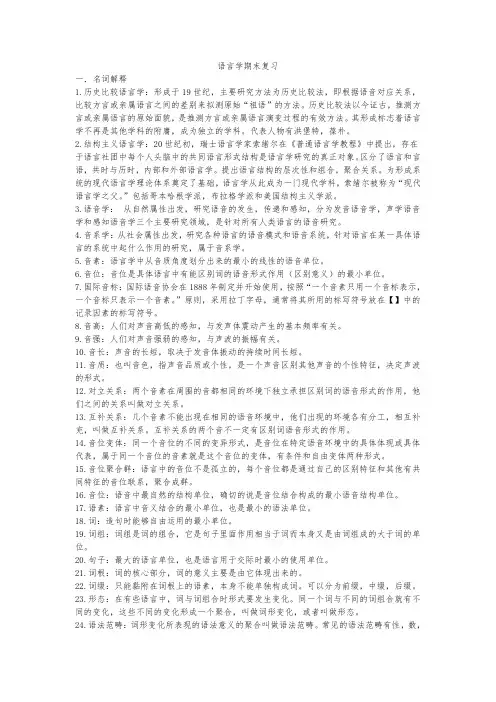
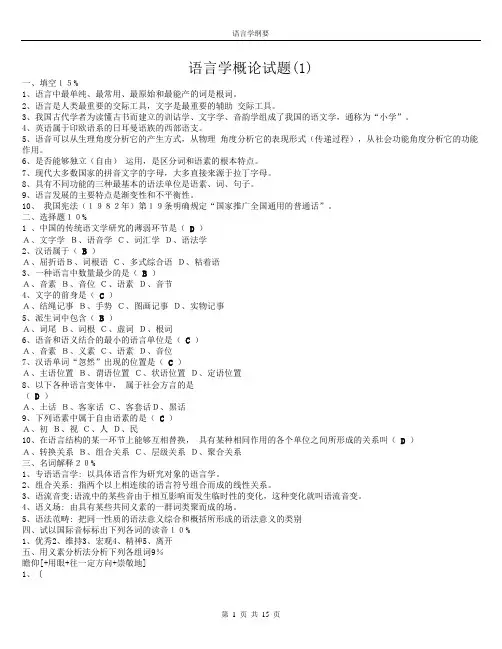
语言学概论试题(1)一、填空15%1、语言中最单纯、最常用、最原始和最能产的词是根词。
2、语言是人类最重要的交际工具,文字是最重要的辅助交际工具。
3、我国古代学者为读懂古书而建立的训诂学、文字学、音韵学组成了我国的语文学,通称为“小学”。
4、英语属于印欧语系的日耳曼语族的西部语支。
5、语音可以从生理角度分析它的产生方式,从物理角度分析它的表现形式(传递过程),从社会功能角度分析它的功能作用。
6、是否能够独立(自由)运用,是区分词和语素的根本特点。
7、现代大多数国家的拼音文字的字母,大多直接来源于拉丁字母。
8、具有不同功能的三种最基本的语法单位是语素、词、句子。
9、语言发展的主要特点是渐变性和不平衡性。
10、我国宪法(1982年)第19条明确规定“国家推广全国通用的普通话”。
二、选择题10%1 、中国的传统语文学研究的薄弱环节是(D )A、文字学B、语音学C、词汇学D、语法学2、汉语属于(B )A、屈折语B、词根语C、多式综合语D、粘着语3、一种语言中数量最少的是(B )A、音素B、音位C、语素D、音节4、文字的前身是(C )A、结绳记事B、手势C、图画记事D、实物记事5、派生词中包含(B )A、词尾B、词根C、虚词D、根词6、语音和语义结合的最小的语言单位是(C )A、音素B、义素C、语素D、音位7、汉语单词“忽然”出现的位置是(C )A、主语位置B、谓语位置C、状语位置D、定语位置8、以下各种语言变体中,属于社会方言的是(D )A、土话B、客家话C、客套话D、黑话9、下列语素中属于自由语素的是(C )A、初B、视C、人D、民10、在语言结构的某一环节上能够互相替换,具有某种相同作用的各个单位之间所形成的关系叫(D )A、转换关系B、组合关系C、层级关系D、聚合关系三、名词解释20%1、专语语言学: 以具体语言作为研究对象的语言学。
2、组合关系: 指两个以上相连续的语言符号组合而成的线性关系。
3、语流音变:语流中的某些音由于相互影响而发生临时性的变化,这种变化就叫语流音变。
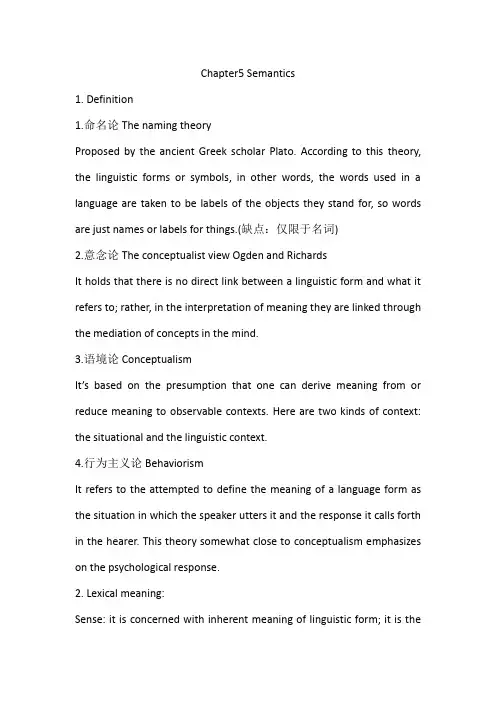
Chapter5Semantics1. Definition1.命名论The naming theoryProposed by the ancient Greek scholar Plato. According to this theory, the linguistic forms or symbols, in other words, the words used in a language are taken to be labels of the objects they stand for, so words are just names or labels for things.(缺点:仅限于名词)2.意念论The conceptualist view Ogden and RichardsIt holds that there is no direct link between a linguistic form and what it refers to; rather, intheinterpretationof meaning they are linked through the mediation of concepts in the mind.3.语境论ConceptualismIt’sbasedonthepresumptionthatonecanderivemeaning fromorreducemea ningtoobservablecontexts.Herearetwokindsofcontext:thesituationalandt helinguisticcontext.4.行为主义论BehaviorismIt refers to the attempted to define the meaning of a language form as the situation in which the speaker utters it and the response it calls forth in the hearer. This theory somewhat close to conceptualism emphasizes on the psychological response.2.Lexicalmeaning:Sense:itisconcernedwithinherentmeaningoflinguisticform;itisthecollectionofallfeaturesoflinguisticform;itisabstractandde-contextualized. Reference:itmeansthelinguisticformreferstothereal,physicalworld.Itdeals withtherelationshipbetweenthelinguisticelementandthenon-linguisticwo rldofexperience.3. Main sense relations1.同义词Synonymy Itreferstothesamenessorclosesimilarityofmeaningorwecansaythatwordsa recloseinmeaningarecalledsynonyms.(1)Dialectal synonyms—synonyms used in different regional dialects(方言)British Americaautumnfallflatapartment(2)Stylistic synonyms---Synonyms differing in style(文体)Old man daddy father male parent(3)Synonyms that different intheiremotive or evaluative meaning(情感)Collaborator VS Accomplice(4)Collocational synonyms(搭配)Accuse VS Charge(accuse…of; charge…with)Rotten tomatoes VS Addled eggs(5)Semantically different synonyms(语义)AmazeVSAstoundItreferstodifferentwordsmayhavethesameorsimilar meaning;thesameonewordmayhavemorethanonemeaning.Ball:1. anroundobjectusedingame.2.alargeformalsocialeventatwhichpeopledance.3.同音(形)异义HomonymyIt refers to the phenomenon that words have different meanings have the same form, i.e., different words are identical in sound or spelling, or in both.1). Homophones同音异义It refers to two words are identical in sound. E.g. rain/reign.2).Homographs同形异义It refers to two words are identical in form.E.g. tear v. /tear n.3). Complete homonyms同形同音Itreferstowordsthatarebothidenticalinsoundandspelling.E.g.tearv./tearn.4.上下义关系HyponymyItreferstothesenserelationbetweenamoregeneral,moreinclusive wordandamorespecificword.Thewordwhichismoregeneralinmeaningis calledsuperordinate,andthemorespecificwordsarecalleditshyponyms. Superordinate:animalSubordinate:cat,dog,tiger,lion,wolf,elephant,fox,bear,It is the term used for oppositeness of meaning on different dimension.a) gradable:等级反义词old-youngb) complementary:互补反义词male-femalec) relational:关系反义词father-son buy-sell4.Sentencesenserelations:1).X is synonymous with Y(同义)E.g. He is a bachelor all his life.He never married all his life.2). X is inconsistent with Y(不一致/反义)E.g. John is marriedJohn is a bachelor.3).X entails Y. (Y is an entailment of X)(包含于)E.g. He has been to France.He has been to Europe.4). X presuppose Y(Y是X的先决条件)E.g.John’s bike needs repairing.John has a bike.5). X is a contradiction(X是一个矛盾句)E.g. My unmarried sister is married to a bachelor.6). X is semantically anomalous.(语义异常)E.g. The table has bad intensions.5.Analysisofmeaning1. Componential Analysis成分分析法----分析词汇抽象意义It’s awayproposedbythestructuralsemanticiststoanalyzewordmea ning.Thisapproachisbaseduponthebeliefthatmeaningofawordcanbedis sectedintomeaningcomponents,calledsemanticfeatures.E.g.Man=Adult+Male+Animate+Human2. Predication Analysis述谓结构分析(由British Linguist G.Leech提出)It’s a new approach for sentential meaning analysis. Predication is usually considered an important common category shared by propositions, questions, commands etc.(通过对论元argument和谓语predicate的分析,达到对句子意义进行分析的许多模式中的一种.)3.先设前提PresuppositionIt’s a semantic relationship or logical connection. A presupposes B.4.蕴涵EntailmentEntailmentcanbeillustratedbythefollowingtwosentencesinwhichsent enceAentailssentenceB.A:Markmarriedablondeheiress.B:Markmarriedablonde.第6章pragmatics本章要点:1.speech act theory言语行为的理论2. cooperative principle and its maxims合作原则及其准则3.Grice an theory of conventional implicature格莱斯会话含义理论本章考点:语用学的定义;语义学与语用学的区别;语境与意义;言语行为理论(发话行为、行事行为和取效行为);合作原则。
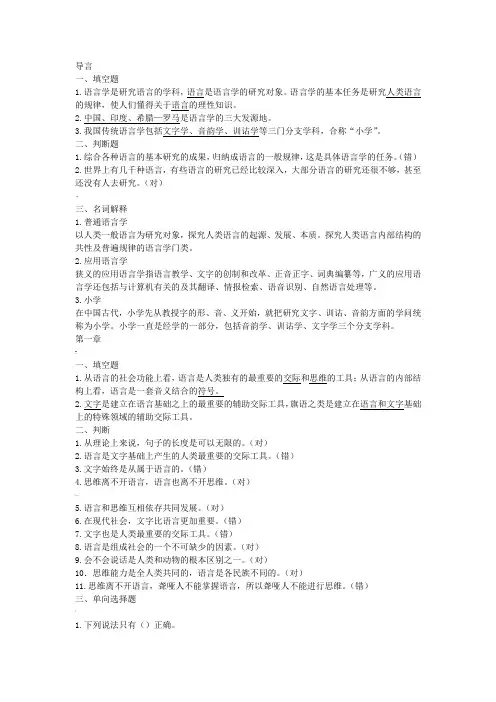
导言一、填空题1.语言学是研究语言的学科,语言是语言学的研究对象。
语言学的基本任务是研究人类语言的规律,使人们懂得关于语言的理性知识。
2.中国、印度、希腊—罗马是语言学的三大发源地。
3.我国传统语言学包括文字学、音韵学、训诂学等三门分支学科,合称“小学”。
二、判断题1.综合各种语言的基本研究的成果,归纳成语言的一般规律,这是具体语言学的任务。
(错)2.世界上有几千种语言,有些语言的研究已经比较深入,大部分语言的研究还很不够,甚至还没有人去研究。
(对)·三、名词解释1.普通语言学以人类一般语言为研究对象,探究人类语言的起源、发展、本质。
探究人类语言内部结构的共性及普遍规律的语言学门类。
2.应用语言学狭义的应用语言学指语言教学、文字的创制和改革、正音正字、词典编纂等,广义的应用语言学还包括与计算机有关的及其翻译、情报检索、语音识别、自然语言处理等。
3.小学在中国古代,小学先从教授字的形、音、义开始,就把研究文字、训诂、音韵方面的学问统称为小学。
小学一直是经学的一部分,包括音韵学、训诂学、文字学三个分支学科。
第一章?一、填空题1.从语言的社会功能上看,语言是人类独有的最重要的交际和思维的工具;从语言的内部结构上看,语言是一套音义结合的符号。
2.文字是建立在语言基础之上的最重要的辅助交际工具,旗语之类是建立在语言和文字基础上的特殊领域的辅助交际工具。
二、判断1.从理论上来说,句子的长度是可以无限的。
(对)2.语言是文字基础上产生的人类最重要的交际工具。
(错)3.文字始终是从属于语言的。
(错)4.思维离不开语言,语言也离不开思维。
(对)—5.语言和思维互相依存共同发展。
(对)6.在现代社会,文字比语言更加重要。
(错)7.文字也是人类最重要的交际工具。
(错)8.语言是组成社会的一个不可缺少的因素。
(对)9.会不会说话是人类和动物的根本区别之一。
(对)10.思维能力是全人类共同的,语言是各民族不同的。
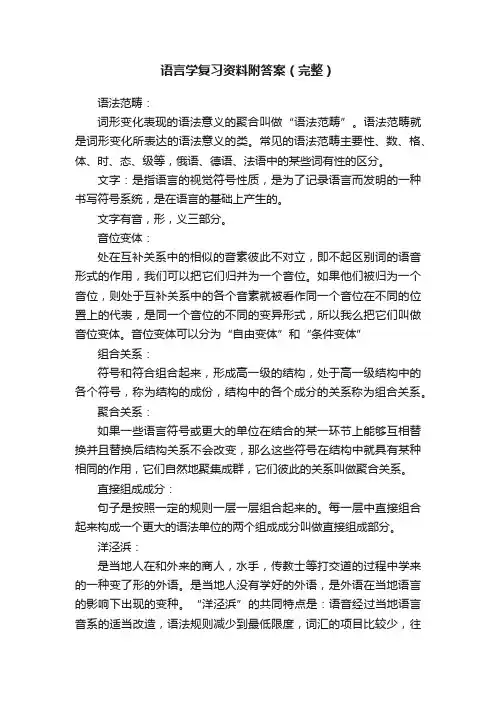
语言学复习资料附答案(完整)语法范畴:词形变化表现的语法意义的聚合叫做“语法范畴”。
语法范畴就是词形变化所表达的语法意义的类。
常见的语法范畴主要性、数、格、体、时、态、级等,俄语、德语、法语中的某些词有性的区分。
文字:是指语言的视觉符号性质,是为了记录语言而发明的一种书写符号系统,是在语言的基础上产生的。
文字有音,形,义三部分。
音位变体:处在互补关系中的相似的音素彼此不对立,即不起区别词的语音形式的作用,我们可以把它们归并为一个音位。
如果他们被归为一个音位,则处于互补关系中的各个音素就被看作同一个音位在不同的位置上的代表,是同一个音位的不同的变异形式,所以我么把它们叫做音位变体。
音位变体可以分为“自由变体”和“条件变体”组合关系:符号和符合组合起来,形成高一级的结构,处于高一级结构中的各个符号,称为结构的成份,结构中的各个成分的关系称为组合关系。
聚合关系:如果一些语言符号或更大的单位在结合的某一环节上能够互相替换并且替换后结构关系不会改变,那么这些符号在结构中就具有某种相同的作用,它们自然地聚集成群,它们彼此的关系叫做聚合关系。
直接组成成分:句子是按照一定的规则一层一层组合起来的。
每一层中直接组合起来构成一个更大的语法单位的两个组成成分叫做直接组成部分。
洋泾浜:是当地人在和外来的商人,水手,传教士等打交道的过程中学来的一种变了形的外语。
是当地人没有学好的外语,是外语在当地语言的影响下出现的变种。
“洋泾浜”的共同特点是:语音经过当地语言音系的适当改造,语法规则减少到最低限度,词汇的项目比较少,往往要借助于迂回曲折的总说法指称事物。
“洋泾浜”是一定社会条件下的产物,只有口头形式,用于和外国人交往的特殊场合,没有人把它看作母语作为第一语言。
语言和言语语言的交际功能就是通过言语形式来实现的。
语言学中把对语言的运用及其成果成为言语,通俗点讲言语就是说话(或写作)和所说(所写)的话语言是从言语中概括出来的的为社会所公认的词语和规则的总和。
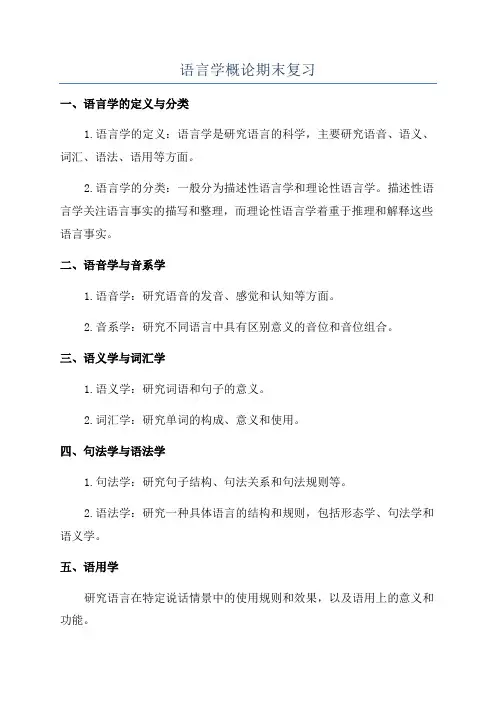
语言学概论期末复习一、语言学的定义与分类1.语言学的定义:语言学是研究语言的科学,主要研究语音、语义、词汇、语法、语用等方面。
2.语言学的分类:一般分为描述性语言学和理论性语言学。
描述性语言学关注语言事实的描写和整理,而理论性语言学着重于推理和解释这些语言事实。
二、语音学与音系学1.语音学:研究语音的发音、感觉和认知等方面。
2.音系学:研究不同语言中具有区别意义的音位和音位组合。
三、语义学与词汇学1.语义学:研究词语和句子的意义。
2.词汇学:研究单词的构成、意义和使用。
四、句法学与语法学1.句法学:研究句子结构、句法关系和句法规则等。
2.语法学:研究一种具体语言的结构和规则,包括形态学、句法学和语义学。
五、语用学研究语言在特定说话情景中的使用规则和效果,以及语用上的意义和功能。
六、语言变异与语言变化1.语言变异:指在同一语言系统中,由于不同地区、社会阶层、年龄、性别、职业等因素的影响而导致的语言差异。
2.语言变化:指随着时间的推移,语言的音、词、句结构等方面发生的变化。
七、语言习得与语言教学1.语言习得:指儿童在自然环境中学会和使用语言的过程。
2.语言教学:指通过教育和训练,使学习者能够掌握一门或多门语言的过程。
八、语言研究方法1.实证研究方法:通过观察和实验来收集语言数据,运用统计学和计量学的方法进行分析和解释。
2.理论分析方法:运用逻辑推理和归纳方法,通过对语言现象的分析和解释来推导出理论。
九、跨学科研究十、未来发展趋势1.数字化语言研究:随着科技的发展,数字化语料库的建立和分析方法的创新将对语言研究提供更多资源和方法。
2.跨学科研究的深入发展:语言学与其他学科的交叉合作将带来新的理论和方法的发展。
3.语言多样性的保护和研究:对于濒危语言和语言多样性的保护和研究将成为未来的重点。
以上是对语言学概论课程的复习内容的总结。
通过对这些内容的学习和理解,我们可以更加深入地了解语言学的研究领域和方法,为进一步深入学习语言学提供基础。
一、选择(20个)二、判断(10~20个)三、填空(5分)四、词语解释(3个,各5分)五、简答(2个,各10分;其中一个是语用学)六、句子分析(4个)IC analysis 是倒着的树形图Chomsky 是有S, NP,VP…与其中的树形图。
1. Phonetics & Language Introduction:1. There is no logical connection between meaning and sounds. A dog might be a pig if only the first person or group of persons had used it for a pig. This is __B____one of the design features of language.A. dualityB. arbitrarinessC. productivityD. displacement2. Language is a system of two sets of structures, one of sounds and the other of meaning. This is __B__ . It makes people possible to talk everything within his knowledge.A. dualityB. arbitrarinessC. productivityD. displacement3. __C___ refers to the ability to construct and understand an indefinitely large number of sentences in one‟s native language, including those that he has never heard before, but that are appropriate to the speaking situation.A. dualityB. arbitrarinessC. productivityD. displacement4. ___D__ refers to the fact that one can talk about things that are not present, as easily as he does things present. The dog couldn‟t be bow-wowing sorrowfully for some lost love or a bone to be lost.A. dualityB. arbitrarinessC. productivityD. displacement5. ___D___ means language is not biologically transmitted from generation to generation, but the linguistic system must be learnt anew by each speaker.A. dualityB. ArbitrarinessC. interchangeabilityD. cultural transmission6. ___C___ means that any human being can be both a producer and a receiver of messages.A. dualityB. ArbitrarinessC. interchangeabilityD. cultural transmission7. To say “How are you. ”“Hi”to your friends is the ___C____of language.A. directive functionB. informative functionC. phatic function (adj. 交流感情/交际应酬的)D. interrogative function8. “Tell me the result when you finish.”If you want to get your hearer to do something, you should use the ___B__ function of language.A. directive functionB. informative functionC. phatic functionD. interrogative function9. A linguist regards the changes in language and language use as _____.A. unnaturalB. something to be fearedC. natural C. abnormal10. A linguist is interested in _______.A. speech sounds onlyB. all soundsC. vowels only C. consonants only11. Which of the following sounds is a voiceless bilabial stop?A. [t]B. [m]C. [b]D. [p]12. Which of the following sounds is a voiced affricate?A. [y]B. [t∫]C. [z]D. [dЗ]13. Which of the following sounds is a central vowel?A. [ ə ]B. [ i ]C. [ou]D. [a: ]14. In the following sounds , ______ is a palatal fricative ?A. [ s ]B. [∫]C. [ l ]D. [θ]15. In the following sounds , ______ is a voiceless affricative ?A. [dЗ]B. [ v ]C. [t∫]D. [θ]16. In English if a word begins with a [ l ] or [ r ],then the next sound must be a ____.A. fricativeB. nasal soundC. semi-vowelD. vowel17. Of the “words”listed below, _____ is not an English word ?A. [r∧b ]B. [ læ b ]C. [məsta:∫]D. [lmæp]18. _____ are produced when the obstruction created by the speech organs is total and audibly released.A. Back vowelsB. StopsC. Fricatives C. Glides19. The International Phonetic Association devised the INTERNATIONAL PHONETIC ALPHABET in ______.A. 1965B. 1957C. 1888D. 178820. ____ is a phonological unit , and it is a unit that is of distinctive value.A. PhoneB. PhonemeC. AllophoneD. SoundII. Tell which statements are true or false.1. [ f ] is a dental consonant.2. Phonology studies the characteristics of speech sounds and provides methodsfor their description, classification and transcription.3. Phoneme is a phonological unit.4. Phone is a phonetic unit.5. When we study the different [ p ]’s in “[ pit ], [tip ], [spit ]”, they are similarphones which belong to phonetics.6. But the three [ p ] belong to the different phoneme / p /.7. The three / p / are allophones.8. ‘peak’is aspirated , phonetically transcribed as [ph]; ‘speak’isunaspirated (不送气的)phonetically[ p=].9. [ph ], [p=] do not belong to the same phoneme / p /.10. [p h] and [ p=] are two different phones, and are variants of the phoneme / p /,which is called ALLOPHONES of the same phoneme.key: BACDD CCACA DDABC DDBCB FFTTT FTTFTI. Choose the best choice(语音)1. Which is a voiced bilabial stop?A. [m]B. [v]C. [p]D. [b]2. Which is a voiceless affricate?A. [w]B. [f]C. [t∫]D. [n]3. Which is monophothong?A. [i]B. [au]C. [ai]D. [ei]4. Which is a voiceless bilabial stop?A. [p]B. [m]C. [b]D. [t]5. Which is a voiced affricate?A. [j]B. [z]C. [t∫]D. [dЗ]6. Which is a central vowel ?A. [i]B. [ə:]C. [ou]D. [a:]7. In English if a word begins with [l] or [r] , then the next sound must be a ____.A. fricativeB. nasal soundC. semi-vowelD. vowel8. Which is a palatal fricative?A. [s]B. [k]C. [∫]D. [l]9. Which is not a English word?A. [r ٨b]B. [læb]C. [sta:∫]D. [ lmæp]10. Which is a unaspirate?A. skyB. killC. likeD. kite2. Semantics 练习1._______ is not included in Leech‟s associative meaning.A. Connotative meaningB. Social meaningC. Collocative meaningD. Thematic meaning2. Among Leech‟s seven types of meaning is concerned with the relationship betweena word and the thing it refers to _______.A. conceptualB. affectiveC. reflectedD. thematic3. According to the referential theory, a word is not directly related to the thing it refers to. They are connected by ______.A. meaningB. referenceC. conceptD. sense4.”Big” and “Small” are a pair of ______ opposites.A. complementaryB. gradableC. completeD. Converse5. The pair of words “lend” and “borrow” are ______.A. gradable opposites B, converse opposites C. co-hyponyms D. synonyms6. A word with several meaning is called ______ word.A. a polysemousB. a synonymousC. an abnormalD. a multiple7. The semantic compone nts of the word “gentleman” can be expressed as ___.A. +animate, +male, +human, -adultB. +animate, +male, +human, +adultA. +animate, -male, +human, -adult D. + animate, -male, +human, +adult8. _____ is a phrase which can only be understood as a unit, not as a summation of themeaning of each constituent word.A. CollocationB. IdiomC. Semantic componentD. Synonym9. In the triangle advanced by Ogden and Richards, “thought or reference” is____A. word, sentenceB. the objectC. conceptD. symbol10. A linguistic is interested in _____.A. What is said.B. What is right both in syntax and in semantics.C. What is grammaticalD. What ought to be said.11. The pair of words “lend” and “borrow” are _____.A. gradable oppositesB. relational oppositesC. synonymsD. co-hyponyms12. Nouns, verbs, and adjectives can be classified as _____.A. Lexical wordsB. grammatical wordsC. function wordsD. form words13. What is t he meaning relationship between the two words “flower/tulip” ?A. PolysemyB. HomonymyC. HyponymyD. Antonymy14. The words “railway” and “railroad” are _____.A. synonyms differing in emotive meaningB. dialectal synonymsC. collocationally-restricted synonymsD. synomyms differing in styles15. The pair of words “wide/narrow” are called____.A. gradable oppositesB. complementary antonymsC. co-hyponymsD. relational opposites16. Which of the following two-term sets shows the feature of complementaries?A. single/marriesB. lend/borrowC. hot/coldD. old/youngDACBB _BBBB BACBA AII. Answer the questions with “Yes”or “No” .1.Is reference tied to a particular time and place? Y2.Every word in a language can find at least one referent in the objective world. ?N3.Can different expressions have the same referent? Y4.Can reference be applied to words such as “and” ,”very” in English? NIII.State the following sentences “True” or “False”.1. Sense is regarded as a kind of intra-linguistic relationship. T2. In most cases, “sense” and “meaning” are different terms for the same thing. T3. Every word has its own sense. F4. A word may have several different senses and several words may have the samesense. T5. Extension, like denotation, is a kind of relation between elements and theobjective world. T6. Extension can only be applied to the things at present. F7. The relation between extension and intension is the same as that betweendenotation and sense. T8. People of different cultures may choose different prototype for the same predicate,e.g. …bus‟. T9. All the words in a language can be used to refer , but only some have sense. F10. Two synonymous words must be identical in sense in every dimension. F11. There are very few perfect synonyms in a language. T12. Entailment is more inclusive than paraphrase. T13. Almost every word in a dictionary is polysemic. T14. Dry and wet are a pair of gradable antonyms. T15. Innocent and guilt are a pair of relative antonyms. F Complementary16. The relationship between the Argument and Predicate is Subject to predicate.F17. The meaning of each expression can be defined in terms of its semanticcomponents so as to contrast with the meaning of all the expressions in the same language. T18. The proposition of a sentence may be more simply stated as a verb and a selection of case ---categories. T19. According to case grammar, the part of proposition in a sentence is a tensed set of relationships between a verb and a noun phrase ( or noun phrases).4. Exercises to Chapter 4 SyntaxI. General view of syntax1. Syntax: studies the rules governing the way words are combined to form sentences.2. gender: as masculine, feminine, neuter, or animate, and inanimate.3. case: the syntaxtic relationship between words. Teacher‟s , kiss him宾格,主格,与格,芬兰语有15种格4.Concord: agreement: a syntactic relationship agree with each other.5. Government : A word determines the form of others.支配关系6. langue and paroleLangue: abstract linguistic system shared by all the members of a speechcommunity. StabilityParole: actual speech7. signified (concept) and signifier (sound image)1. 所指 2 能指之间的关系是任意的8. syntagmatic and paradigmatic relationsSyntagmatic: what precedes or follows9. synchronic and diachronic linguistics10. “Rheme” “Theme”负载交际能力最小的是主位。
第一章绪论1.1什么是语言1.2语言的性质(1)语言具有系统性(systematic )(2)语言是一个符号系统语言符号是一种象征符号。
(3)语言符号的任意性(arbitrariness )与理据性(motivation )(4)口头性(5)语言是人类特有的(6)语言是用于交际的寒暄交谈(phatic communion )马林诺夫斯基提出的,认为语言除了用于表达思想、交流感情外,还可以用语言营造一种气氛或保持社会接触。
这种不用于表达思想、交流感情的语言使用,叫寒暄交谈。
1.3语言的起源1.4语言的分类1.4.1系属分类(Genetic Classification )历史比较语言学通过比较各种语言在不同时期语音、词性、曲折变化、语法结构上的相同特点来建立语言族系。
将语言分为语系(family )——语族(group )——语支(branch )——语言英语、德语属印欧语系日耳曼语族西日耳曼语支。
法语属印欧语系罗曼语族中罗曼语支。
汉语属汉藏语系汉语族。
1.4.2 类型分类(Typological Classifacation )根据词的结构类型,可分为(1)孤立语(isolating isolating languagelanguage )又叫词根语,一个词代表一个意思,缺少形态变化,语序和虚词是表达语法意义的主要手段。
汉语是典型的孤立语。
(2)粘着语(agglutinative language )简单词组成复合词,而词性和意义不变。
在词根前、中、后粘贴不同的词缀实现语法功能。
日语、韩语、土耳其语是典型的黏着语。
(3)屈折语(inflectional inflectional languagelanguage )词形变化表语法关系的语言。
英语是不太典型的屈折语。
(4)多式综合语(polysynthesis polysynthesis languagelanguage )把主、宾和其它语法项结合到动词词干上以构成一个单独的词,但表达一个句子的意思。
语言学-期末复习资料-整理版Chapter one Introduction一、定义1.语言学LinguisticsLinguistics is generally defined as the scientific study of language.2.普通语言学General LinguisticsThe study of language as a whole is often called General linguistics.3.语言language$Language is a system of arbitrary vocal symbols used for human communication.语言是人类用来交际的任意性的有声符号体系。
4.识别特征Design FeaturesIt refers to the defining poperties of human language that distinguish it from any animal system of communication.语言识别特征是指人类语言区别与其他任何动物的交际体系的限定性特征。
Arbitrariness任意性Productivity多产性¥Duality双重性Displacement移位性Cultural transmission文化传递⑴arbitrarinessThere is no logical connection between meanings and sounds.the arbitrary nature of language is a sign of sophisticationand it makes it possible for language to have an unlimited source of expressions⑵ProductivityAnimals are quite limited in the messages they are able to send."⑶DualityLanguage is a system, which consists of two sets of structures ,or two levels.⑷DisplacementLanguage can be used to refer to contexts removed from the immediate situations of the speaker.⑸Cultural transmissionHuman capacity for language has a genetic basis, but we have to be taught and learned the details of any language system. this showed that language is culturally transmitted. not by instinct. animals are born with the capacity to produce the set of calls peculiar to their species.5.语言能力CompetenceCompetence is the ideal u ser’s knowledge of the rules of his langu age.。
语言学期末复习资料语言学I.单选:1.Theub-fieldoflinguiticthattudietherelationbetweenlanguageandocietyi called________.A.ociolinguiticB.neurolinguiticC.macrolinguiticD.microlinguitic2.Whichofthefollowingdoentbelongtodialectalvarietie_______.A.regionaldialectB.ociolectC.idiolectD.digloia3.Thedialectwhichicauedbyocialtatui________.A.regionaldialectB.ociolectC.idiolectD.digloia4.Standarddialecti_________.A.deignatedatheofficialornationallanguageofacountryB.adialectachildacquirenaturallylikehiregionaldialectC.uedbypeoplewhopeakdifferentlanguageforretrictedpurpoeD.uedbypeoplewhobelongtothehigherocialtatuA.bilingualimB.digloiaC.pidginD.creole6.WhichofthefollowingdoeNOTcontitutethereaonforregionaldiale ctA.Geographicalbarrier.B.Loyaltytoonenativepeech.C.Thee某itenceoftandarddialect.D.Phyicalandpychologicalreitancetochange.7.ApeakeruetheStandardEnglihdialectwheninteractingwithtrange r,and语言学ueadifferentdialectwheninteractingwithindividualwhomherecogn izeamemberofherownocialgroup.Thiillutratewhichofthefollowingtype oflinguiticbehaviorA.Hypercorrection.B.Negativetranfer.C.Code-witching.D.Borrowing.8.WhichofthefollowingtatementinottheconcernofociolinguiticA.Thelanguageaperonuerevealhiocialbackground.B.Theree某itocialnormthatdeterminethetypeoflanguagetobeuedonacertainoccaio n.C.Howdoethehumanmindworkwhentheyuelanguage.D.Toinvetigatetheocialapectoflanguage.language.Thiicalled________.A.cientificlanguageB.idiolectC.colloquiallanguageD.formallan guage10.Theformofagivenlanguageuedinacertaingeographicalpaceicall ed____.A.tyleB.dialectC.regiterD.pidgin11.AccordingtoSapir-whorfHypothei,whichofthefollowingiNOTtrueA.Differentlanguageofferpeopledifferentwayofe某preingtheworldaround.nguagefilterpeopleperceptionandthewaytheycategorizee某perience.nguagepatterndetermineorinfluencepeoplethinkingandbehavi or.nguagetructurepeoplehabituallyuehownoinfluenceonpeoplebe havior.12.Whichofthefollowingabouttherelationhipbetweenlanguageandc ultureiNOTtruenguageueitintedwithitculture.nguagee某preeculturalreality.语言学C.Therelationhipianalogoutothatoftructureandprocee.D.Therelationhipoflanguagetocultureithatofparttowhole.13.Thefamouline“Myloveiared,redroe.”tirupvividlytheimagina tionofabeautifullady.Thiithe_______meaningof“roe”.A.denotativeB.connotativeC.iconicD.dictionary14.Themeaningcanbefoundinthedictionaryithe_______meaningofaw ord.A.denotativeB.connotativeC.iconicD.culture15.InEnglih,“green”inthephrae“green-eye”iaociatedwith________.A.unhappyfeelingB.highocialpoitionC.envyorjealouyD.negativeq ualitie16.Francehamadepecialefforttoprotectitlanguagefrombeingcorru ptedbyotherlanguageepeciallyAmericanEnglih.Thiiakindof________.A.linguiticimperialimB.linguiticnationalimC.culturalimperial imD.culturaldiffuion17.TheSapir-Whorfhypotheiiabout________.nguageandthoughtnguageandtranlationC.grammaticaltruc tureD.econdlanguageacquiition18.Sapir-Whorfhypotheiialoknownalinguitic________.A.reliabilityB.relativityC.reveribilityD.reachabilityB.Studyingnonverbalbehaviorcanleadtothedicoveryofacultureund erlyingattitudeandvalue.C.Nonverbalactionalwayoccuriniolation.语言学20.WhichtatementiNOTrightindecribingthebehavioritviewA.Behavioritviewtreeimitation,timulationandreinforcement.B.Behavioritofferareaonableaccountofhowchildrenacquireomeoft heregularandroutineapectofthelanguage.C.Behavioritholdthatchildrenlearnthelanguagegraduallyinmucht heamewayahabit-forming.21.AccordingtoChomky,theUniveralGrammari________.A.gotthroughimitationandpracticeB.acquiredthroughtheinteractionwiththeenvironmentC.pre-equippedinchildrenbrainD.gainedpecificallyforeachlanguage22.WhichofthefollowingtatementitrueA.Allnormalchildrenhaveequalabilityinlearningtheirfirtlangua ge.B.Linguiticenvironmentplayanimportantroleinfirtlanguagelearn ing.D.Itieayforparenttoteachtheirchildrengrammar.23.Thechildmaygetconfuedathearingthecolorofwhiteuedforpaperw henhe/hefirtthoughtiathewordfornow.Thiiane某amplefor________.A.under-e某tenionB.over-e某tenionC.hearingimpairmentD.mentalretardation24.Aroundtheageof2,childrenbegintoproducetwo-wordutteranceucha“mommyock”,whichofthefollowingtatementaboutth iiNOTtrue.A.Thikindofpeechicalledtelegraphicpeech.语言学B.Thikindofpeechicalledcaretakertalk.C.Therearecontentwordinthepeech.D.Therearenotfunctionelementinthepeech.25.Thechildrenknowthetabooword,thepoliteformofaddreingduring ___.A.pragmaticdevelopmentB.atypicaldevelopmentC.grammaticaldevelopmentD.vocabularydevelopment26.Thetheoryofuniveralgrammarwapropoedby______.A.NoamChomkyB.FirthC.F.D.SauureD.Sapir27.ThefollowingtatementabouterroranalyiaretrueE某CEPT_______.A.theoncepredominantcontrativeanalyiwagraduallyreplacedbyerr oranalyi.B.differentfromcontrativeanalyi,erroranalyigiveleconideratio ntonativelanguage.D.twomainortoferrorwerediagnoed:interlingualerrorandintralin gualerror.28.SomeChineelearnerofEnglihtendtopronounce“three”a“tree ”and“thi”a“di”.Thiicauedby_________.A.interlingualinterferenceB.intralingualinterferenceC.cognit ivefactorD.emanticchangeA.ytematocityB.permeabilityC.foilizationD.ubtitution30.Generally4typeofmotivationhavebeenidentifiedintheecondlan guagelearning“Learnerlearnaecondlanguagefore某ternalpurpoe.”icalled_______motivation.语言学A.intrumentalB.integrativeC.reultativeD.intrinic31.Amongvarioudiviionoflearningtrategie.ThoebyChamot(1986)an dO某ford(1990)arewidelyaccepted.“Thetechniqueinplanningmonitoringan devaluatingonelearning”icalled________.A.cognitiveB.metacognitiveC.affectD.ocial32.Inthefollowingtatementaboutmotivation,whichoneiNOTtrueA.Itidefinedathelearnerattitudeandaffectivetateorlearningdri ve.B.Ithaatrongimpactonalearnereffortinlearningaecondlanguage.C.Itplayanimportantroleinlearnerueoflearningtrategie.D.Itoccuronlywhenlearnerlearnaecondlanguagefore某ternalpurpoe.33.________InputHypotheiioneofthemotfamoutheorieamongdiffere ntmodeloflanguageacquiition.A.KrahenB.ChomkyC.AutineD.Halliday34.Thetudyoftherelationhipbetweenbrainandlanguageicalled____ ___.A.ociolinguiticB.macrolinguiticC.microlinguiticD.neurolinguitic35.ThebraintemmaintaintheeentialfunctionE某CEPT______.A.heartrateB.mucleco-ordinationC.repirationD.memory36.The“rightearadvantage”mean________.A.therightearhaanadvantagefortheperceptionoflinguiticignal.B.therightearibetteratenvironmentalounduchabirdongC.humanbeingcangetoundonlyfromtherightear语言学37.WhichofthefollowingtatementiNOTtrueA.Theinformationfromtheleftideofthebodyireceivedonlybytherig htideofthebrainandvicevera.B.Theinformationfromtheleftideofthebodyireceivedonlybythelef tideofthebrainandvicevera.C.Thebrainidividedintotwoection:thelowerectioncalledthebrain temandhigherectioncalledcerebrum.D.Thecorte某ieparatedbythelongitudinalfiureinto2part:theleftandrightcerebral hemiphere.38.________refertothelearninganddevelopmentofalanguage.nguageacquiitionnguageproductionnguageintruction________inmorphology.A.backformationB.converionC.blendingD.acronymhighwayerveA.ane某preivefunction.B.aninformativefunction.C.aperformativefunction.D.aperuaivefunction.41.Linguiticdeterminimandlinguiticrelativityhavealternativel ybeenuedtoreferto_____.B.Sapir-WhorfHypothei语言学C.anthropologicallinguitic42.ThemotrecentadvanceinCDtechnologyuedinCALLithedevelopment of_____.A.CD-ROMB.CD-RC.CD-ID.HVD43.WhatdoemouepotatomeanA.amouepadB.amouehapedlikeapotatoC.apotatoafoodforthemoue44.Whichofthefollowingformofwritingaremorelikelytoueforegrou ndingA.Poetry.B.Diary.C.ReearchPaper.D.Novel.45.“_____”ioftenundertoodaalanguageytembetweenthetargetlan guageandthelearnernativelanguage.A.InputHypotheiB.Sapir-WhorfHypotheiC.InterlanguageD.ContrativeAnalyi单选答案:1-10:ADBABCCCBB11-20:DCCACBABCD21-30:CBABAACACC语言学31-40:BDADDABACC41-45:BBDACII.多选题:1.WhichofthefollowingareforegroundedA.The1960dreamofhighrielivingoonturnedintoanightmare.B.Thepeechwamade29October1941totheboyatChurchilloldpublicchool,Harrow.C.Neverinthefieldofhumanconflictwaomuchowedbyomanytoofew.D.Wehavenotjourneyedacrothecenturie,acrotheocean,acrothemountain,acrotheprairie,becauewearemadeofugarcandy.2.WhichofthefollowingincludeametonymyA.Bythihourthevolcanicfireofhinaturehadburntdown.B.Thekettleboil.ndbelongtothecrown.D.Theyhaveafleetoffiftyail.3.WhichofthefollowinglinearemotlikelyfromthepoemofE.E.Cummin gA.l(a/le/af/fa/ll/)/one/l/ineB.amwa.areleavefewthi.itheeaor/cratchilyoverwhichofearthdrag gedonceC.ihadanunclenamed/SolwhowaabornfailureandD.AwomanIforwore;butIwillprove,/Thoughbeingagodde,Iforworeno tthee:4.Whichofthefollowinginvolvegeneralconte某teffectwhatititalkingabout.语言学B.Youdonotundertandaentencebutwhenyoureadthene某tentenceyoucanknowthemeaningofthefirtone.C.Youdonotknowwhyinaforeignmoviepeopleayyeatheyhaketheirhead.D.Youdonotknowwhatate某tiaboutuntilyouaregiventhetitleofthete某t.5.WhichofthefollowingtatementcanbemadeaboutociolinguiticA.Ithacontributedtoafrehlookatthenatureoflanguagedevelopment andue.B.Ithacontributedtothedevelopmentoftheoreticallinguitic.C.Ithacontributedtoachangeofemphaiinthecontentoflanguageteac hing.D.Ithacontributedtoinnovationinmaterialandactivitieforthelan guageclaroom.A.Itialargebodyofmachine-readablete某t.B.Itiacollectionoflinguiticdata.C.Itmainpurpoeitoverifyahypotheiaboutlanguage.D.Itdealwiththeprincipleandpracticeofuingcorporainlanguagetu dy.7.WhichofthefollowingtermarerelatedtoCognitiveLinguiticA.Wordrecognition.nguageacquiition.C.Contrualoperation.D.Categorization.8.WhichofthefollowingareNOTtrueofthe“womenregiter”A.Womenuemore“fancy”colorterm.B.Womenuetrongerwearingword.C.Womenuemoreintenifier.D.Womenuemoredirecte某preion.语言学9.WhichofthefollowingincludeametaphorA.Hieyecameoutofhiheadlikeaprawn.B.Thehallwaywazebra-tripedwithdarkneandmoonlight.C.Thethoughtwaafireinhim.D.Theworldialooking-gla,andgivebacktoeverymanthereflectionofhiownface.10.WhichofthefollowingarewritingoftreamofconciouneA.PrideandPrejudiceB.TotheLighthoue.C.AILayDying.D.JaneEyre.11.Whichofthefollowingbooktitlecontain“alliteration”A.VowelandCononant.B.GonewiththeWind.C.Se某andtheCity.D.TheWonderofWord.多选答案:1-5:CD,BC,ABC,AC,ACD,6-10:ABC,CD,BD,BCD,BC,11:BCD,III.DecidewhetherthefollowingtatementareTrue(T)orFale(F).(10 point,1pointeach)1)Dualityrefertothepropertyofhavingtwoleveloftructure,uchthatunitof2)ArticulatoryPhonetictudiethephyicalpropertieofpeechound.3)Theadjectiveianopenclaofword.4)The“partofpeech”intraditionalgrammarioftenreferredtoa“w ordcla”today.5)“Hot”and“cold”areconvereantonym.6)Theholophratictageithematurephaeoflanguageacquiition.语言学7)Menuetrongercurewordthanwomen.8)TheRelevanceTheorywauggetedbyH.P.Grice.9)StreamofconciounewauedinthewritingofWilliamFaulkner.10)Machinetranlationcanbeuedforretrictedtechnicalpurpoe,ucha theweatherreport.辨析题答案:1.T2.F3.T4.T5.F6.F7.T8.F9.T10.TDecidewhetherthefollowingtatementaretrueorfale.(15point)1.Arbitrarinemeanyoucanuelanguageinanywayyoulike.2.TheEnglihyllablemayhaveamanyathreecononantinthecodapoition.3.Whendividingyllable,wenormallyputcononantinthecodapoition.4.“Radar”ianinventedword.5.Thecononant[某]e某itedinOldEnglih.6.TodaywenormallyaythatEnglihhatwotene:preentandpat.8.Leechconceptualmeaninghatwoide:eneandreference.9.Inlogicalymbol,mean“all”andmean“ome”.10.Deviationcorrepondtothetraditionalideaofpoeticlicene:thew riterofliteratureiallowed–incontrattotheeverydaypeaker–todeviatefromrule,ma某im,orconvention.11.Coupletaretwolineofvere,uuallyconnectedbyarhyme.12.Alanguagethathaevencolortermhareachedthelattageofevolutio n.13.InHopi,aimplequetionlikeAreyougoingtoeatriceandcaavanowwillhaveeveraldifferenttranlationinaccordancewiththeactualit uation.14.MTcannowberealizedontheinternet.15.Aconcordanceialitingoftheconte某tinwhichawordappear,a语言学正误辨析答案:。
语言学概论练习题(一、二)第一部分语言与语言学一.填空题1.中国、印度、希腊—罗马具有悠久的历史文化传统,是语言学的三大发源地。
2. _文言___是我国古代的书面语,用它写成的文章称为文言文。
3.文字学、音韵学、训诂学是我国传统的语文学。
4.研究语言的结构,主要是研究语音、词汇、语法三个部分。
5.运用语言传递信息的过程,可以分为编码、发送、传递、接收、解码五个阶段。
6.人和动物的区别是人会制造工具,而且人类有语言,这是人和动物相区别的重要标志之一。
7.一种语言中的句子数量是无限的,人类之所以能掌握语言,是因为构成句子的_规则_是十分有限的。
8.语言是人类社会的交际工具,而且也是思维的工具。
9.在一定条件下,身体姿势等伴随动作还可以离开语言独立完成交际任务。
例如汉民族点头表示肯定,摇头表示否定,送别时挥手表示再见,鼓掌表示欢迎,咬牙切齿表示愤怒,手舞足蹈表示兴奋。
10.人的大脑分左右两半球,大脑的左半球控制语言活动,右半球掌管不需要语言的感性左直观思维。
11.汉语的哥哥、弟弟,英语用 siste 表示,汉语的舅父、姨父、姑父、叔叔,英语用uncle 表示。
12.英语可以直接用数词修饰名词,汉语数词修饰名词一般要加上一个量词。
13.儿童最早的智力活动就是学习语言。
14.任何符号,都是由形式和意义两个方面构成的。
15.一个符号,如果没有意义,就失去了存在的必要,如果没有形式,我们就无法感知,符号也就失去了存在的物质基础。
16.语言符号是语音和意义的统一体,声音是语言符号的形式。
17.用什么样的语音形式代表什么样的意义,完全是由使用这种语言的社会成员约定俗成。
18.语言符号具有任意性和线条性特点。
19.语言的底层是一套音位,上层是符号和符号的序列,可以分为若干级,第一级是语素,第二级是词,第三级是句子。
20.语言系统中的所有符号,既可以同别的符号组合,又可以被别的符号替换,符号之间的这两种关系是组合关和聚合关系。
语言学概要期末复习一、单选1、下列不属于语法研究的三个层面之一的是(A )A、词汇B、语用C、语义D、句法2、下列不属于基本词汇的特征之一的是( C )A、全民常用性B、历史稳定性C、约定俗成性D、构词能产性3、下列不属于语言的三要素的是( B )A、语音B、语用C、语义D、语法4、“a”的音变属于哪一种(D )A、脱落B、同化C、异化D、增音5、儿化属于哪一种音变(D )A、脱落B、同化C、异化D、增音6、一、七、八、不的音变属于哪一种(C )A、脱落B、同化C、异化D、增音7、考研究生属于哪种语法关系(A )A、动作和目的B、动作和原因C、动作和受事D、动作和结果8、打球属于哪种语法关系(C )A、动作和目的B、动作和原因C、动作和受事D、动作和结果8、打玻璃属于哪种语法关系(C )A、动作和目的B、动作和原因C、动作和受事D、动作和结果9、救火属于哪种语法关系(B )A、动作和目的B、动作和原因C、动作和受事D、动作和结果10、做饭属于哪种语法关系(D )A、动作和目的B、动作和原因C、动作和受事D、动作和结果10、吃食堂属于那种语法关系( D )A、动作和目的B、动作和原因C、动作和受事D、动作和处所11、下列哪一种不属于综合性语法手段(D )A、词序B、附加手段C、异根D、虚词12、下列哪一种不属于分析性语法手段(B )A、词序B、附加成分C、语调D、虚词13、“千里迢迢”属于哪一种语法单位(C )A、语素B、词C、短语D、句子14、“人民”属于哪一种语法单位(B )A、语素B、词C、短语D、句子15、“桌子”的“子”属于哪一种语法单位(A )A、语素B、词C、短语D、句子二、填空1、语言是人类独有的,用来交际和思维的最重要的一种符号系统。
2、舌面前、高、不圆唇元音是(i [ i ] )3、舌尖前、不送气、清、塞擦音是(z [ ts ] )4、汉( [ xan51 ] ) 言([ iɛn 35 ] )5、语([ y 214 ] )文([ tsI 51 ] )6、朋友属于哪一种构词法(并列),黑板(偏正),司机(动宾),雪白(状中),足球(定中)地震(主谓),英语(定中),粉红(定中)理想(并列)7、啤酒(音译加注)可口可乐(音译加意译)沙发(音译)8、克里奥尔语(混合)语言的灭绝(融合)外来词(借用)9、全民语言在地域上的分支叫(地域方言)。
I. 单选:1. The sub-field of linguistics that studies the relation between language and society iscalled ________.A. sociolinguisticsB. neurolinguisticsC. macrolinguisticsD. microlinguistics2. Which of the followings doesn‟t belong to dialectal varieties? _______.A. regional dialectB. sociolectC. idiolectD. diglossia3. The dialect which is caused by social status is ________.A. regional dialectB. sociolectC. idiolectD. diglossia4. Standard dialect is _________.A. designated as the official or national language of a countryB. a dialect a child acquires naturally like his regional dialectC. used by people who speak different languages for restricted purposeD. used by people who belong to the higher social status5. Sometimes, two varieties of a language exist side by side throughout the community, with each having a definite role to play. This phenomenon is _____.A. bilingualismB. diglossiaC. pidginD. creole6. Which of the followings does NOT constitute the reason for regional dialect?A. Geographical barrier.B. Loyalty to one‟s native speech.C. The existence of standard dialect.D. Physical and psychological resistance to change.7. A speaker uses the Standard English dialect when interacting with strangers, anduses a different dialect when interacting with individuals whom she recognizes as members of her own social group. This illustrates which of the following types of linguistic behavior?A. Hypercorrection.B. Negative transfer.C. Code-switching.D. Borrowing.8. Which of the following statements is not the concern of sociolinguistics?A. The language a person uses reveals his social background.B. There exist social norms that determine the type of language to be used on a certain occasion.C. How does the human mind work when they use language.D. To investigate the social aspects of language.9. The word “language”is sometimes used to refer to the whole of a person‟slanguage. This is called ________.A. scientific languageB. idiolectC. colloquial languageD. formal language10. The form of a given language used in a certain geographical space is called ____.A. styleB. dialectC. registerD. pidgin11. According to Sapir-whorf Hypothesis, which of the following is NOT true?A. Different languages offer people different ways of expressing the world around.B. Language filters people‟s perception and the way they categorize experiences.C. Language patterns determine or influence people‟s thinking and behavior.D. Language structure people habitually use shows no influence on people‟s behavior.12. Which of the following about the relationship between language and culture is NOT true?A. Language use is tinted with its culture.B. Language expresses cultural reality.C. The relationship is analogous to that of structures and processes.D. The relationship of language to culture is that of part to whole.13. The famous line “My love is a red, red rose.” stirs up vividly the imagination of a beautiful lady. This is the _______ meaning of “rose”.A. denotativeB. connotativeC. iconicD. dictionary14. The meaning can be found in the dictionary is the _______ meaning of a word.A. denotativeB. connotativeC. iconicD. culture15. In English, “green” in the phrase “green-eyes” is associated with ________.A. unhappy feelingsB. high social positionC. envy or jealousyD. negative qualities16. France has made special efforts to protect its language from being corrupted by other languages especially American English. This is a kind of ________.A. linguistics imperialismB. linguistic nationalismC. cultural imperialismD. cultural diffusion17. The Sapir-Whorf hypothesis is about ________.A. language and thoughtB. language and translationC. grammatical structureD. second language acquisition18. Sapir-Whorf hypothesis is also known as linguistics ________.A. reliabilityB. relativityC. reversibilityD. reachability19. Which of the following statements about nonverbal communication is NOT true?A. Nonverbal communication and culture are similar in that both are learned, both are passed on from generation to generation, and both involve shared understandings.B. Studying nonverbal behavior can lead to the discovery of a culture‟s underlying attitudes and values.C. Nonverbal actions always occur in isolation.D. Nonverbal communication has five basic functions: to repeat, to complement, to substitute for a verbal action, to regulate, and to contradict a communication event.20. Which statement is NOT right in describing the behaviorists‟ view?A. Behaviorists view stresses imitation, stimulation and reinforcement.B. Behaviorists offer a reasonable account of how children acquire some of the regular and routine aspects of the language.C. Behaviorists hold that children learn the language gradually in much the same way as habit-forming.D. behaviorist‟s accounts are convincing especially when it is used to explain children‟s acquiring complex system.21. According to Chomsky, the Universal Grammar is ________.A. got through imitation and practiceB. acquired through the interaction with the environmentC. pre-equipped in children‟s brainsD. gained specifically for each language22. Which of the following statements is true?A. All normal children have equal ability in learning their first language.B. Linguistic environment plays an important role in first language learning.C. A child can begin his first language acquisition at any time.D. It is easy for parents to teach their children grammar.23. The child may get confused at hearing the color of white used for paper when he/ she first thought is as the word for snow. This is an example for ________.A. under-extensionB. over-extensionC. hearing impairmentD. mental retardation24. Around the age of 2, children begin to produce two-word utterances such as “mommy sock”, which of the following statements about this is NOT true.A. This kind of speech is called telegraphic speech.B. This kind of speech is called caretaker talk.C. There are content words in the speech.D. There are not function elements in the speech.25. The children know the taboo words, the polite forms of addressing during ___.A. pragmatic developmentB. atypical developmentC. grammatical developmentD. vocabulary development26. The theory of universal grammar was proposed by ______.A. Noam ChomskyB. FirthC. F.D. Saussure D. Sapir27. The following statements about error analysis are true EXCEPT _______.A. the once predominant contrastive analysis was gradually replaced by error analysis.B. different from contrastive analysis, error analysis gives less consideration to native language.C. error analysis compares the forms and meanings across the native and target languages.D. two main sorts of errors were diagnosed: interlingual errors and intralingual errors.28. Some Chinese learners of English tend to pronounce “three” as “tree” and “this”as “dis”. This is caused by _________.A. interlingual interferenceB. intralingual interferenceC. cognitive factorsD. semantic change29. The common errors such as “he/ she has/ have to touch the society” in Chinese English learners belong to _______.A. systematocityB. permeabilityC. fossilizationD. substitution30. Generally 4 types of motivation have been identified in the second language learning “Learners learn a second language for external purpose.” is called _______ motivation.A. instrumentalB. integrativeC. resultativeD. intrinsic31. Among various divisions of learning strategies. Those by Chamot (1986) and Oxford (1990) are widely accepted. “The techniques in planning monitoring and evaluating one‟s learning” is called ________.A. cognitiveB. metacognitiveC. affectD. social32. In the following statements about motivation, which one is NOT true?A. It is defined as the learner‟s attitudes and affective state or learning drive.B. It has a strong impact on a learner‟s efforts in learning a second language.C. It plays an important role in learners‟ use of learning strategies.D. It occurs only when learners learn a second language for external purpose.33. ________‟s Input Hypothesis is one of the most famous theories among different models of language acquisition.A. KrashenB. ChomskyC. AustineD. Halliday34. The study of the relationship between brain and language is called _______.A. sociolinguisticsB. macrolinguisticsC. microlinguisticsD. neurolinguistics35. The brain stem maintains the essential functions EXCEPT ______.A. heart rateB. muscle co-ordinationC. respirationD. memory36. The “right ear advantage” means ________.A. the right ear has an advantage for the perception of linguistic signals.B. the right ear is better at environmental sounds such as bird songsC. human beings can get sounds only from the right earD. the left ear can‟t get the linguistic signals at any time37. Which of the following statements is NOT true?A. The information from the left side of the body is received only by the right side of the brain and vice versa.B. The information from the left side of the body is received only by the left side of the brain and vice versa.C. The brain is divided into two sections: the lower section called the brain stem and higher section called cerebrum.D. The cortex is separated by the longitudinal fissure into 2 parts: the left and right cerebral hemispheres.38. ________ refers to the learning and development of a language.A. Language acquisitionB. Language comprehensionC. Language productionD. Language instruction39. The word “Motel”comes from “motor + hotel”. This is an example of________ in morphology.A. backformationB. conversionC. blendingD. acronym40. Language is t tool of communication. The symbol “Highway Closed”on ahighway servesA. an expressive function.B. an informative function.C. a performative function.D. a persuasive function.41. …Linguistic determinism‟ and …linguistic relativity‟ have alternatively been used torefer to _____.A. cross-cultural communicationB. Sapir-Whorf HypothesisC. anthropological linguisticsD. ethnography of communication42. The most recent advance in CD technology used in CALL is the development of_____.A. CD-ROMB. CD-RC. CD-ID. HVD43. What does …mouse potato‟ mean?A. a mouse padB. a mouse shaped like a potatoC. a potato as food for the mouseD. a computer addict44. Which of the following forms of writing are more likely to use foregrounding?A. Poetry.B. Diary.C. Research Papers.D. Novels.45. “_____” is often understood as a language system between the target language and the learner‟s native language.A. Input HypothesisB. Sapir-Whorf HypothesisC. InterlanguageD. Contrastive Analysis单选答案:1-10:A D B A B C C C B B11-20:D C C A C B A B C D21-30:C B A B A A C A C C31-40:B D A D D A B A C C41-45: B B D A CII. 多选题:1. Which of the following are foregrounded?A. The 1960 dream of high rise living soon turned into a nightmare.B. The speech was made 29 October 1941 to the boys at Churchill‟s old publicschool, Harrow.C. Never in the field of human conflict was so much owed by so many to so few.D. We have not journeyed across the centuries, across the oceans, across themountains, across the prairies, because we are made of sugar candy.2. Which of the following include a metonymy?A. By this hour the volcanic fires of his nature had burnt down.B. The kettle boils.C. Lands belong to the crown.D. They have a fleet of fifty sails.3. Which of the following lines are most likely from the poems of E. E. Cummings?A. l(a / le / af / fa / ll / s) / one / l / inessB. am was. are leaves few this. is these a or / scratchily over which of earth draggedonceC. i had an uncle named / Sol who was a born failure andD. A woman I forswore; but I will prove, / Though being a goddess, I forswore notthee:4. Which of the following involve …general context effects‟?A. You can understand every word of a baseball commentary but you do not knowwhat it is talking about.B. You do not understand a sentence but when you read the next sentence you canknow the meaning of the first one.C. You do not know why in a foreign movie people say yes as they shake theirheads.D. You do not know what a text is about until you are given the title of the text.5. Which of the following statements can be made about sociolinguistics?A. It has contributed to a fresh look at the nature of language development and use.B. It has contributed to the development of theoretical linguistics.C. It has contributed to a change of emphasis in the content of language teaching.D. It has contributed to innovations in materials and activities for the languageclassroom.6. Which of the following statements are true of a computer corpus?A. It is a large body of machine-readable texts.B. It is a collection of linguistic data.C. Its main purpose is to verify a hypothesis about language.D. It deals with the principles and practice of using corpora in language study.7. Which of the following terms are related to Cognitive Linguistics?A. Word recognition.B. Language acquisition.C. Construal operations.D. Categorization.8. Which of the following are NOT true of the “women register”?A. Women use more “fancy” color terms.B. Women use stronger swearing words.C. Women use more intensifiers.D. Women use more direct expressions.9. Which of the following include a metaphor?A. His eyes came out of his head like a prawn‟s.B. The hallway was zebra-striped with darkness and moonlight.C. The thought was a fire in him.D. The world is a looking-glass, and gives back to every man the reflection of hisown face.10. Which of the following are writings of stream of consciousness?A. Pride and PrejudiceB. To the Lighthouse.C. As I Lay Dying.D. Jane Eyre.11. Which of the following book titles contain “alliteration”?A. Vowels and Consonants.B. Gone with the Wind.C. Sex and the City.D. The Wonder of Words.多选答案:1-5:CD,BC,ABC,AC,ACD,6-10:ABC,CD,BD,BCD,BC,11:BCD,III. Decide whether the following statements are True (T) or False (F). (10 points,1 point each)1) Duality refers to the property of having two levels of structures,such that unitsofthe primary level are composed of elements of the secondary level and each of the two levels has its own principles of organization.2) Articulatory Phonetics studies the physical properties of speech sounds.3) The adjective is an open class of words.4) The “parts of speech” in traditional grammar is often referred to as “wordclass” today.5) “Hot” and “cold” are converse antonyms.6) The holophrastic stage is the mature phase of language acquisition.7) Men use stronger curse words than women.8) The Relevance Theory was suggested by H. P. Grice.9) Stream of consciousness was used in the writings of William Faulkner.10) Machine translation can be used for restricted technical purposes, such as theweather report.辨析题答案:1. T2. F3. T4. T5. F6. F7. T8. F9. T 10. TDecide whether the following statements are true or false. (15 points)1. Arbitrariness means you can use language in any way you like.2. The English syllable may have as many as three consonants in the codaposition.3. When dividing syllables, we normally put consonants in the coda position.4. “Radar” is an invented word.5. The consonant [x] existed in Old English.6. Today we normally say that English has two tenses: present and past.7. According to J. Firbas, Communicative Dynamism refers to “the extent towhich the sentence element contributes to the development of thecommunication.”8. Leech‟s conceptual meaning has two sides: sense and reference.9. In logical symbols, ∀means “all” and ∃means “some”.10. Deviation corresponds to the traditional idea of poetic license: the writer ofliterature is allowed – in contrast to the everyday speaker – to deviate fromrules, maxims, or conventions.11. Couplets are two lines of verse, usually connected by a rhyme.12. A language that has seven color terms has reached the last stage of evolution.13. In Hopi, a simple question like …Are you going to eat rice and cassava now?‟will have several different translations in accordance with the actualsituations.14. MT can now be realized on the internet.15. A concordance is a listing of the contexts in which a word appears, asretrieved from a computer corpus.正误辨析答案:。